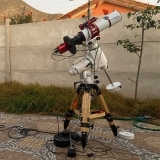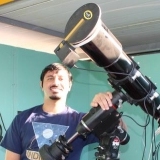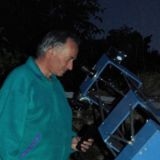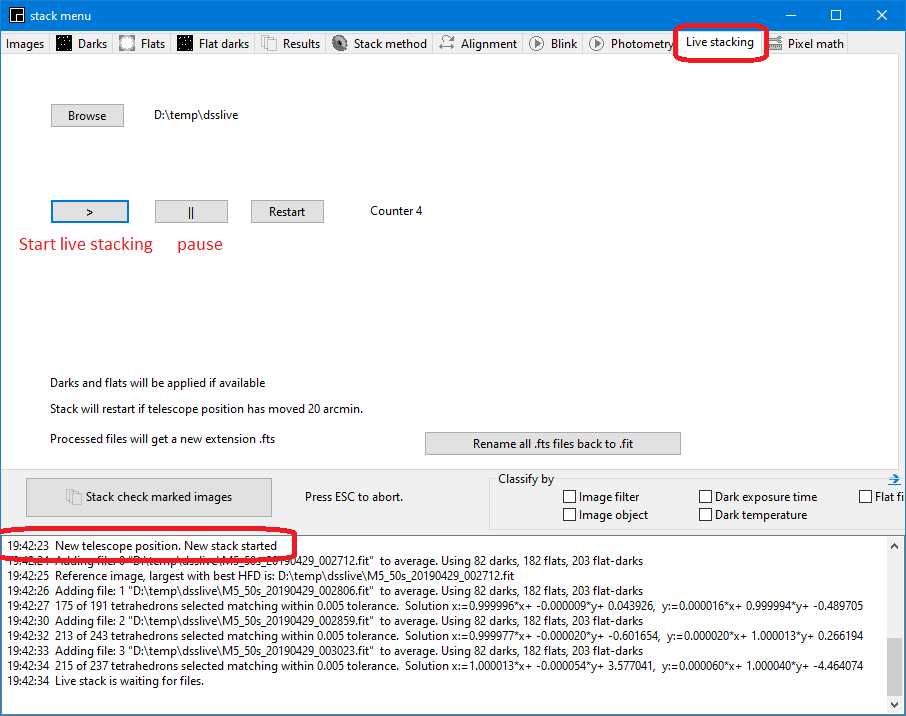INDI Library v2.0.7 is Released (01 Apr 2024)
Bi-monthly release with minor bug fixes and improvements
Live stacking methods?
- Wouter van Reeven
-

- Offline
- Supernova Explorer
-

- Posts: 1957
- Thank you received: 420
Replied by Wouter van Reeven on topic Live stacking methods?
Wouter
Please Log in or Create an account to join the conversation.
Replied by PDB on topic Live stacking methods?
(last time it was the apply button after selecting log histogram). Please detach it from KSTARS before applying new functionality.
Rgrds,
Paul
Please Log in or Create an account to join the conversation.
Replied by han on topic Live stacking methods?
I also had a brief look to DSS live. That looks nice but somehow people are only using it in combination with AstroToaster. What's wrong with DSS live only?
I assume the main benefit is that this solution can be used in Linux. The other programs look pretty established in Windows.
What to do with the input files. Maybe delete? Renaming is possible but it will produce huge amount of data since the setup is most likely operated with short exposure times. If I work this concept further out, I don't want to add more options.
Flowchart for images A, B, C, D...:
result1:=A
plot result1
result2:=(result1*1+B )/2
plot result 2
result3:=(result2*2+C)/3
plot result 3
result4:=(result3*3+D)/4
plot result 4
result5:=(result4*4+E)/5
plot result 5
...
The images in the above process with master dark and flat & flats dark corrected
Viewer maintains the actual view position and zoom factor
Please Log in or Create an account to join the conversation.
- Jasem Mutlaq
-
 Topic Author
Topic Author
- Away
- Administrator
-

Replied by Jasem Mutlaq on topic Live stacking methods?
I already started adding ASTAP integration to Ekos as an alternative solver and hopefully by the next release we'd have something stable.
Regarding how to handle input files, this should be an option, because I could be running an actual sequence and just want to see the how the live stacking is going.
Please Log in or Create an account to join the conversation.
- Patrick Chevalley
-

- Offline
- Elite Member
-

- Posts: 211
- Thank you received: 104
Replied by Patrick Chevalley on topic Live stacking methods?
Han, this is good if you add this function to ASTAP.
From my experience in CCDciel, it work better with a simple addition of each new frame. This is because people doing EAA don't really fear about star saturation but want the faint nebulae level to increase as quickly as possible. When you divide by the number of frame, you keep the faint nebula level very low, as it was on a single image, just with less noise. Also 60 x 5 sec. do not saturate more than 1 x 300 sec.
But the best option is to do the stacking in 32bit floating point, then scale to 16bit for the display.
Maybe with ASTAP you can also try to keep every frame to redo the full stacking each time, in this case you can use sigma clipping to improve the result. If I understand correctly this is what AstroToaster do.
And as Jasem say this can also be used to preview the result of a standard sequence, not only for EAA.
At the moment CCDciel shift the image with a single star alignment before stacking. This work fine with unguided mount but not with alt/az mount. It is good if ASTAP can also apply a rotation but this imply that more than one star can be measured in the frame.
Patrick
Please Log in or Create an account to join the conversation.
Replied by han on topic Live stacking methods?
It will stack all file(s) in the specified directory. If it is finished it will wait for new file(s). If a file is detected which is 20 arcmin away from the previous files (idea Wouter), a new stack will be started automatically. You can save the stack results from the viewer menu .
I haven't tested under clear skies but it seems to work well. Please tell me if this is useful and report possible bug(s) or improvements.
To identify files which are processed , they are renamed to the extension *.fts. You can rename them back with the button at the bottom.
If it works well, then I will compile the program for Raspberry Pi.
Patrick, that' s no problem. ASTAP stacks always using floating point arrays.
Clear skies, Han
Please Log in or Create an account to join the conversation.
Replied by T-Studio on topic Live stacking methods?
I was trying to list support for ASTAP in the wish list Ekos alignment module.
ASTAP's Solver is a great help when creating a remote environment with SBC.
Please Log in or Create an account to join the conversation.
Replied by T-Studio on topic Live stacking methods?
(I expect it to be easy to navigate and browse remotely as previously posted.)
Please Log in or Create an account to join the conversation.
Replied by T-Studio on topic Live stacking methods?
Great job!
Please Log in or Create an account to join the conversation.
Replied by han on topic Live stacking methods?
If for Sigma Clip stacking the program keeps all images in memory (e.g. 20 megapixels equals 80 mbyte), the memory usage will rise fast and processing time will increase. You could probably avoid this by using only the first ten images to find statistically the mean and standard deviation of each pixel and to use that to detect outliers in the next images. For the moment, lets first see how the average stacking works and performs. Average stacking using the serial calculation makes it fast and simple.
Han
Please Log in or Create an account to join the conversation.
Replied by han on topic Live stacking methods?
- Stacking works well!
Only there is something wrong with star detection because it didn't work well with H-alpha images and the normal stack routine has not problem with them.
- The switch-over between two different object doesn't work proper. While slewing the incoming images confuse the program. For the time being I just had to stop imaging.
- Unicode fonts didn't work well with my Win7 system.
- Memo containing the fits header is flashing too much.
Improvements will come.
Han
One example made during strong wind:
41x10 seconds live stacking with ASI1600 and HEQ5 mount. No guiding. No darks No flats.
Please Log in or Create an account to join the conversation.
Replied by han on topic Live stacking methods?
Han
Please Log in or Create an account to join the conversation.



